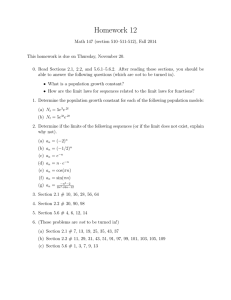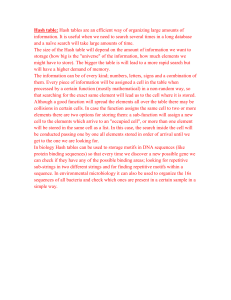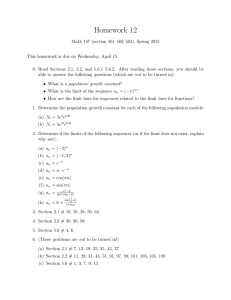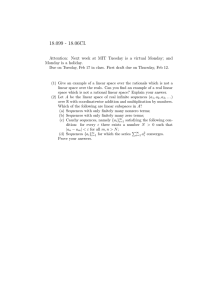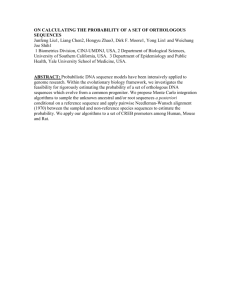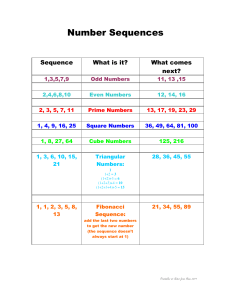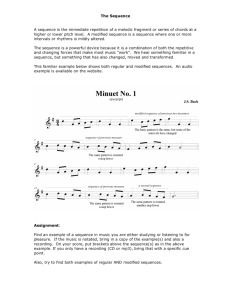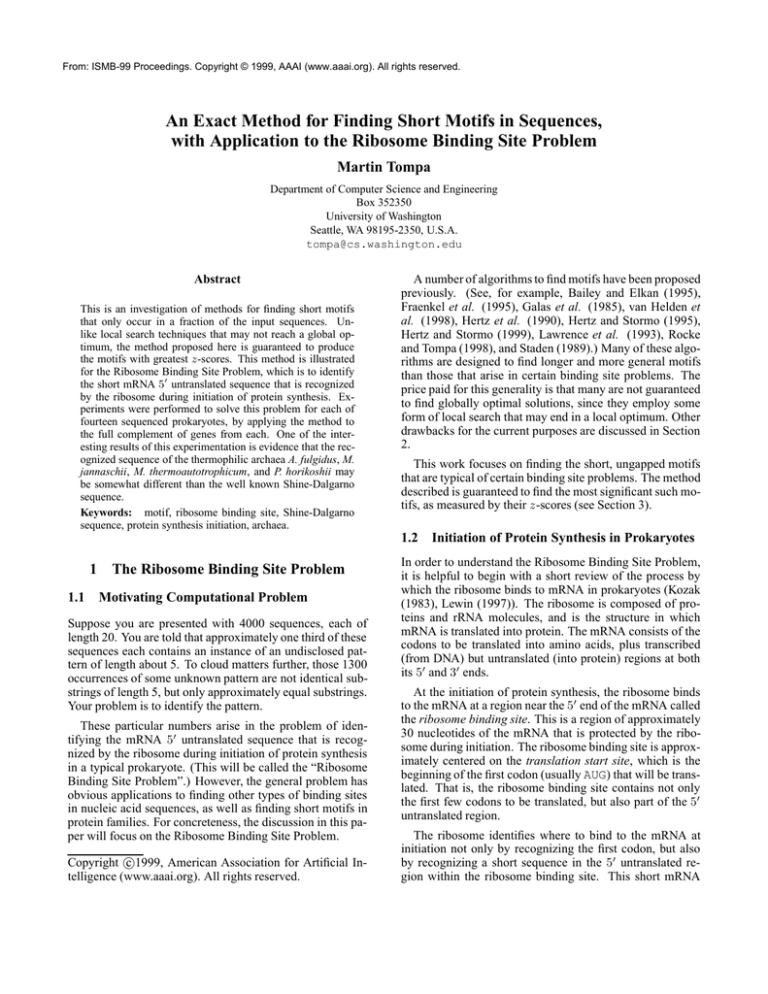
From: ISMB-99 Proceedings. Copyright © 1999, AAAI (www.aaai.org). All rights reserved.
An Exact Method for Finding Short Motifs in Sequences,
with Application to the Ribosome Binding Site Problem
Martin Tompa
Department of Computer Science and Engineering
Box 352350
University of Washington
Seattle, WA 98195-2350, U.S.A.
tompa@cs.washington.edu
Abstract
This is an investigation of methods for finding short motifs
that only occur in a fraction of the input sequences. Unlike local search techniques that may not reach a global optimum, the method proposed here is guaranteed to produce
the motifs with greatest z-scores. This method is illustrated
for the Ribosome Binding Site Problem, which is to identify
the short mRNA 50 untranslated sequence that is recognized
by the ribosome during initiation of protein synthesis. Experiments were performed to solve this problem for each of
fourteen sequenced prokaryotes, by applying the method to
the full complement of genes from each. One of the interesting results of this experimentation is evidence that the recognized sequence of the thermophilic archaea A. fulgidus, M.
jannaschii, M. thermoautotrophicum, and P. horikoshii may
be somewhat different than the well known Shine-Dalgarno
sequence.
Keywords: motif, ribosome binding site, Shine-Dalgarno
sequence, protein synthesis initiation, archaea.
A number of algorithms to find motifs have been proposed
previously. (See, for example, Bailey and Elkan (1995),
Fraenkel et al. (1995), Galas et al. (1985), van Helden et
al. (1998), Hertz et al. (1990), Hertz and Stormo (1995),
Hertz and Stormo (1999), Lawrence et al. (1993), Rocke
and Tompa (1998), and Staden (1989).) Many of these algorithms are designed to find longer and more general motifs
than those that arise in certain binding site problems. The
price paid for this generality is that many are not guaranteed
to find globally optimal solutions, since they employ some
form of local search that may end in a local optimum. Other
drawbacks for the current purposes are discussed in Section
2.
This work focuses on finding the short, ungapped motifs
that are typical of certain binding site problems. The method
described is guaranteed to find the most significant such motifs, as measured by their z-scores (see Section 3).
1.2 Initiation of Protein Synthesis in Prokaryotes
1 The Ribosome Binding Site Problem
1.1
Motivating Computational Problem
Suppose you are presented with 4000 sequences, each of
length 20. You are told that approximately one third of these
sequences each contains an instance of an undisclosed pattern of length about 5. To cloud matters further, those 1300
occurrences of some unknown pattern are not identical substrings of length 5, but only approximately equal substrings.
Your problem is to identify the pattern.
These particular numbers arise in the problem of identifying the mRNA 50 untranslated sequence that is recognized by the ribosome during initiation of protein synthesis
in a typical prokaryote. (This will be called the “Ribosome
Binding Site Problem”.) However, the general problem has
obvious applications to finding other types of binding sites
in nucleic acid sequences, as well as finding short motifs in
protein families. For concreteness, the discussion in this paper will focus on the Ribosome Binding Site Problem.
c
Copyright 1999,
American Association for Artificial Intelligence (www.aaai.org). All rights reserved.
In order to understand the Ribosome Binding Site Problem,
it is helpful to begin with a short review of the process by
which the ribosome binds to mRNA in prokaryotes (Kozak
(1983), Lewin (1997)). The ribosome is composed of proteins and rRNA molecules, and is the structure in which
mRNA is translated into protein. The mRNA consists of the
codons to be translated into amino acids, plus transcribed
(from DNA) but untranslated (into protein) regions at both
its 50 and 30 ends.
At the initiation of protein synthesis, the ribosome binds
to the mRNA at a region near the 50 end of the mRNA called
the ribosome binding site. This is a region of approximately
30 nucleotides of the mRNA that is protected by the ribosome during initiation. The ribosome binding site is approximately centered on the translation start site, which is the
beginning of the first codon (usually AUG) that will be translated. That is, the ribosome binding site contains not only
the first few codons to be translated, but also part of the 50
untranslated region.
The ribosome identifies where to bind to the mRNA at
initiation not only by recognizing the first codon, but also
by recognizing a short sequence in the 50 untranslated region within the ribosome binding site. This short mRNA
Bacillus subtilis
Lactobacillus delbrueckii
Mycoplasma pneumoniae
Mycobacterium bovis
Aquifex aeolicus
Synechocystis sp.
Escherichia coli
Haemophilus influenzae
Helicobacter pylori
Archaeoglobus fulgidus
Methanobacterium thermoautotrophicum
Pyrococcus horikoshii
Methanococcus jannaschii
Mycoplasma genitalium
50 . . .
50 . . .
50 . . .
50 . . .
50 . . .
50 . . .
50 . . .
50 . . .
50 . . .
50 . . .
50 . . .
50 . . .
50 . . .
50 . . .
CUGGAUCACCUCCUUUCUA
CUGGAUCACCUCCUUUCUA
GUGGAUCACCUCCUUUCUA
CUGGAUCACCUCCUUUCU
CUGGAUCACCUCCUUUA
CUGGAUCACCUCCUUU
UUGGAUCACCUCCUUA
UUGGAUCACCUCCUUA
UUGGAUCACCUCCU
CUGGAUCACCUCCU
CUGGAUCACCUCCU
CUCGAUCACCUCCU
CUGGAUCACCUCC
GUGGAUCACCUC
30
30
30
30
30
30
30
30
30
30
30
30
30
30
Table 1: 30 end of 16S rRNA for various prokaryotes
sequence will be called the SD site, for reasons to be made
clear below. The mechanism by which the ribosome recognizes the SD site is relatively simple base-pairing: the SD
site is complementary to a short sequence near the 30 end of
the ribosome’s 16S rRNA.
The SD site was first postulated by Shine and Dalgarno
(1974) for E. coli. Subsequent experiments demonstrated
that the SD site in E. coli mRNA usually matches at least
4 or 5 consecutive bases in the sequence AAGGAGG, and
is usually separated from the translation start site by approximately 7 nucleotides, although this distance is variable.
Numerous other researchers such as Vellanoweth and Rabinowitz (1992) and Mikkonen et al. (1994) describe very
similar SD sites in the mRNA of other prokaryotes. It is not
too surprising that SD sites should be so similar in various
prokaryotes, since the 30 end of the 16S rRNA of all these
prokaryotes is very similar (Mikkonen et al. (1994)). Table
1 shows a number of these rRNA sequences. Note their similarity, and in particular the omnipresence of the sequence
CCUCCU, complementary to the Shine-Dalgarno sequence
AGGAGG.
Because of the great similarity among SD sites in several
prokaryotes, many authors use the term “Shine-Dalgarno sequence” to refer to the particular sequence AAGGAGG, or a
large subsequence of it. The term “SD site” will be used
more generally to mean the short 50 untranslated mRNA motif recognized by the particular organism’s ribosome. For
most bacteria this will in fact be a Shine-Dalgarno sequence
(that is, very similar to AAGGAGG). However, the SD site
need not look like this for all prokaryotes, despite the fact
that the 30 ends of their 16S rRNA sequences are so similar.
In fact, one of the interesting results of this work is evidence
that the SD sites of the thermophilic archaea A. fulgidus, M.
jannaschii, M. thermoautotrophicum, and P. horikoshii may
be somewhat different.
1.3 Correspondence to the Computational
Problem
The Ribosome Binding Site Problem, then, is to identify an
organism’s SD site, given the collection of sequences upstream from its putative genes. How does this correspond to
the computational problem described in Section 1.1?
The prokaryotic genomes currently sequenced each contain between a few hundred and several thousand annotated
genes, so it would be within the normal range for a newly
sequenced genome to have N ≈ 4000 open reading frames
identified as candidate genes. To identify this genome’s SD
site, one must search for instances of a motif of length about
5 within the 20-mer just 50 to the translation start site of each
of these N open reading frames. (For brevity, the 20-mers
from these positions will be called upstream sequences.)
There are several reasons why only a fraction of these N
upstream sequences will contain an SD site:
1. Some of the open reading frames might not be real genes.
2. Some of the putative translation start sites within the open
reading frames might be incorrectly placed.
3. Many of the genes might be parts of operons, which are
multi-gene complexes that are transcribed together, possibly not all containing a ribosome binding site.
4. A number of the genes might employ some completely
different translation initiation mechanism not involving
an SD site. (See, for example, Fargo et al. (1998) and
Loechel et al. (1991).)
The last aspect of the computational problem of Section
1.1 to be justified is the fact that instances of the motif will
match only inexactly. This is so because the hybridization of
the mRNA’s SD site and the ribosome’s 16S rRNA need only
occur with free energy below some negative threshold. The
rules of RNA binding energy (Lewin 1997) govern here so
that, for instance, some strong GC pairs can compensate for a
mismatched pair of residues, and GU “wobble pairs” release
free energy, though not as much as Watson-Crick pairs. In-
dependent of this explanation, it is an easily observable fact
that the collection of SD sites do match only approximately.
1.4
Contributions
In the solutions to the Ribosome Binding Site Problem to
be discussed, no use will be made of known 16S rRNA
sequences to streamline the search for the (approximately)
complementary SD site. The reason for this is to develop
more generally applicable algorithms. As mentioned in Section 1.1, the Ribosome Binding Site Problem is only one instance of many sequence analysis problems that involve the
identification of short motifs. (For other binding site problems, the set of candidate sequences might be found by expression level array experiments (Chu et al. (1998), Roth
et al. (1998)), or by footprinting, after which methods very
similar to those discussed in this paper could be employed.)
Few of these other motif problems have an analogue of the
16S sequence to guide the search. Even for the Ribosome
Binding Site Problem in newly sequenced genomes, the 16S
rRNA sequence is often only predicted by comparison to
previous data (Mikkonen et al. (1994)), and in particular
its exact 30 end may not be known.
However, knowledge of some 16S sequences makes the
Ribosome Binding Site Problem an excellent starting point,
because they can be used to verify the plausibility of the candidate SD sites found. Furthermore, solving the Ribosome
Binding Site Problem is important as a step in the validation of true genes, in the identification of the correct translation start sites, and in the identification of operons. In fact,
this work originated for exactly those reasons, in connection with TIGR’s M. tuberculosis annotation project. Steven
Salzberg sent the author upstream sequences from approximately 4000 M. tuberculosis open reading frames, with a
request to look for the SD site of M. tuberculosis in this
data. The results would be useful to the annotation project in
weeding out open reading frames that do not correspond to
genes, in moving incorrect translation start sites among true
genes, and in identifying operons.
The remainder of this paper describes an investigation of
algorithms for the Ribosome Binding Site Problem. Section 2 discusses some of the previously published methods
for finding motifs, and why most seem insufficient for problems such as the Ribosome Binding Site Problem. Section
3 describes a novel algorithm based on the construction of
certain Markov chains, and Section 4 discusses experimental
results from running this algorithm on the full complement
of gene sequences of each of fourteen annotated prokaryotic
genomes.
2
2.1
Previous Methods for Finding Motifs
Accounting for Absolute Number of
Occurrences
If a short sequence s is to be a motif, the first and most obvious characteristic is that there should be an (approximate)
occurrence of s in many of the N sequences. This basic idea
s
ATAAA
AATAA
AAATA
ATTAA
AAGAA
AAAGA
TAAAA
AAAAT
GAAAA
AGGAA
AATTA
AGAAA
TAAAT
TAAAG
AAGGA
TTAAA
AAAAA
GAAAT
TATAA
AAATT
Ns
1139
1108
1096
1087
1068
1067
1058
1055
1043
1042
1036
1027
1024
1017
1014
1008
1004
993
984
982
Table 2: Twenty most frequently occurring 5-mers in H.
influenzae’s upstream sequences. Ns is the number of sequences containing s, allowing up to one substitution. The
SD site should be a subsequence of TAAGGAGGTGATCCAA.
is at the foundation of Staden’s algorithm for finding motifs
(Staden 1989). He creates a table containing the number
of occurrences of each k-mer s, where an occurrence allows
for a small, fixed number of substitutions of residues in s.
One of the criteria he applies before declaring s a motif is
that the number of such occurrences of s must exceed some
threshold.
To understand why this criterion alone is insufficient, consider Table 2, which shows the 20 most frequently occurring
5-mers among H. influenzae’s upstream sequences, allowing up to 1 substitution. In this and all subsequent examples,
the input is composed of an upstream sequence of length 20
for each annotated gene. In the case of H. influenzae, the
number of upstream sequences is N ≈ 1700.
H. influenzae is an AT-rich genome, and this is true even
for the N upstream sequences, for which the nucleotide frequencies are 41% A, 12% C, 18% G, 29% T. Table 2, rather
than listing likely SD sites, largely reflects the nucleotide biases in the input. The 30 end of the 16S rRNA of H. influenzae (see Table 1) confirms that, with one exception, these
frequent subsequences are not the SD sites sought: the SD
site should be a subsequence of TAAGGAGGTGATCCAA.
2.2 Accounting for Background Distribution
The argument in Section 2.1 illustrates the well known fact
that the identification of motifs must take the nucleotide
background frequencies into account. A popular way that
motif-finding algorithms have done this is to use the “information content” (also called “relative entropy”) of the
motif. (See, for instance, Fraenkel et al. (1995), Hertz et
al. (1990), Hertz and Stormo (1995), Hertz and Stormo
(1999), Lawrence et al. (1993), Rocke and Tompa (1998),
Schneider et al. (1986), and Stormo and Hartzell (1989).)
Staden (1989), realizing the necessity of taking background
frequency into account, also used relative entropy as a second criterion for selecting motifs.
paper. Their method, though, does not allow for inexact
matches among motif instances, and uses a very different
measure of statistical significance of motifs.
The relative entropy of a motif is defined as follows. Suppose that the motif has length k, and has approximate occurrences in a subset S of the N input sequences. Then the
relative entropy of this motif is defined to be
A natural way to take into account both the absolute number
of occurrences and the background distribution is to begin
as in Section 2.1 by creating a table that, for each k-mer s,
records the number Ns of sequences containing an occurrence of s, where an occurrence allows for a small, fixed
number c of substitutions of residues in s. A reasonable
measure of s as a motif, then, would be based on how unlikely it is to have Ns occurrences if the sequences were
drawn at random according to the background distribution.
k
X
X
j=1
r∈{A,C,G,T }
pr,j log2
pr,j
,
br
where pr,j is the frequency with which residue r occurs in
position j among the motif occurrences in S, and br is the
background frequency of residue r. Relative entropy provides a measure of how well-conserved and how unlikely a
motif is with respect to the background distribution. In particular, the more different the distribution {pr,j } from the
background distribution {br }, the higher the relative entropy
of position j.
Relative entropy is a good measure for comparing two
motifs that have the same number of occurrences (that is, occur in equinumerous subsets of the N input sequences), but
not a good measure if the two motifs occur in a vastly different number of sequences. The reason for this is that relative entropy does not take into account the absolute number
of occurrences, depending instead on the relative frequency
pr,j of occurrence of each of the nucleotides. For instance,
for the uniform background distribution, a perfectly conserved motif that occurs in only a few sequences will have a
greater relative entropy than an imperfectly conserved motif that occurs in nearly all the sequences. Because of this,
most of the previous applications that use relative entropy
depend on the fact that the motif occurs in all, or nearly all,
of the N sequences. This is definitely not the case for the
Ribosome Binding Site Problem. Realizing this drawback,
Staden (1989) and Fraenkel et al. (1995) provided separate
criteria to be used in conjunction with relative entropy.
2.3
Accounting for Both Criteria
The conclusion to be drawn from this section is that a good
measure for comparing motifs such as potential SD sites
should take into account both the absolute number of occurrences and the background distribution. One way of doing
this might be to multiply the number of occurrences by the
relative entropy. Stormo (1990) pointed out that this measure is a log likelihood ratio.
In very recent work, Hertz and Stormo (1999) described a
method for estimating the expected frequency of achieving
a given relative entropy score. The authors showed how to
use this method to compare alignments containing differing
numbers of sequences.
Van Helden et al. (1998) employed an enumerative
method similar in outline to that described in the current
3 Statistical Significance of Motif
Occurrences
More specifically, let X be a single random sequence of
the specified length L (L = 20 for upstream sequences),
with residues drawn randomly and independently from the
background distribution, or alternatively generated by a
Markov chain according to the background dinucleotide distribution. Suppose that ps is the probability that X contains
at least one occurrence of the k-mer s, allowing for c substitutions. Under the reasonable assumption that the N sequences are independent, the expected number containing at
least
p one occurrence of s is N ps , and its standard deviation
is N ps (1 − ps ). Therefore, the associated z-score is
Ns − N ps
.
Ms = p
N ps (1 − ps )
(1)
Ms is the number of standard deviations by which the observed value Ns exceeds its expectation, and is sometimes
called the “z-score”, “normal deviate”, or “deviation in standard units” (Alder & Roessler 1972). Ms is asymptotically
normally distributed, and normalized to have mean 0 and
standard deviation 1, making it suitable for comparing different motifs s. Equation (1) will be used as the measure
of s as a motif: it measures how unlikely it is to have Ns
occurrences of s, given the background distribution, and so
incorporates both of the desired criteria.
3.1 The Probability of Occurrence in a Single
Sequence
What remains, then, is to determine ps , the probability that a
single random sequence X of length L contains at least one
occurrence of s. For the case in which no substitutions are
permitted and |s| is not too small, ps can be approximated
well by a certain Poisson process (see Waterman (1995, Section 12.3)). Schbath (1995) extended this to the more general case in which the sequence X is generated by a Markov
chain.
Determining ps exactly via generating functions is a well
studied problem, even for the case in which substitutions, insertions, and deletions are permitted. Even the simplest case
of unbiased coin flips with no such variations permitted is
interesting and somewhat counterintuitive: for the alphabet
{H, T}, uniform distribution, and L = 3, pHH = 3/8 whereas
pHT = 1/2. The cause of the difference is the fact that the
pattern s = HH can overlap itself.
Guibas and Odlyzko (1981, Theorem 3.3) were the first to
exhibit generating functions that determine ps exactly, even
in the presence of substitutions, insertions, and deletions, if
the characters of X are generated independently. Chrysaphinou and Papastavridis (1990, Theorem 4) extended this result to the case in which X is generated by a Markov chain.
The remainder of this paper concentrates on the case of at
most one subsitution, no insertions or deletions, and Markov
chains of order 1, which are the parameters used in the experimentation described in Section 4.
The algorithm to compute ps that is implicit in the works
of Guibas and Odlyzko (1981) and Chrysaphinou and Papastavridis (1990) requires the computation of a determinant of
size (3|s| + 2) × (3|s| + 2), most of whose entries are polynomials of degree at least |s|. This section concludes with
the outline of a more direct and efficient algorithm that was
employed in the subsequent experimentation.
Given a pattern string s, construct a deterministic finite
automaton M that accepts those strings containing a substring that matches s with at most one substitution, as follows. M has a state for every string u that matches a prefix of s with at most one substitution. The transition from
u on input character σ is to that state corresponding to the
longest suffix of uσ, that is, the longest suffix that agrees
with some prefix of s allowing at most one substitution. M
has 1.5|s|2 + O(|s|) states, and can be constructed in time
O(|s|2 ) (Gusfield 1997, Theorem 3.4.1).
Given the transition probabilities aij of the Markov chain
G that generates the random sequence X, transform M into
a Markov chain M 0 (not to be confused with G) by assigning
transition probability aij to those transitions of M labeled j
out of those states whose corresponding string u ends with
the character i. The desired probability ps is given by the
probability, in M 0 , of going from the start state to the accepting state in |X| steps. This can be computed in time
O(|X| · |s|2 ) by exploiting the sparseness of the transition
probability matrix of M 0 . In particular, although that transition matrix has Θ(|s|4 ) entries, each row has only four
nonzero entries, so that each of the |X| matrix-vector product can be computed in time O(|s|2 ).
4
Results
The algorithm of Section 3 was applied to the upstream sequences from each of fourteen prokaryotic genomes, ten of
which are bacteria and four archaea. Nine of the ten bacterial genomes showed a strong predominance of a standard Shine-Dalgarno sequence consisting of most of AAGGAGG. For example, Tables 3 - 5 show the highest scoring
sequences found in H. influenzae, B. subtilis, and E. coli,
respectively. The patterns s in these and subsequent tables
have been aligned by hand to aid visualization.
To verify that the scores in such tables are statistically significant, the algorithm was run on simulated input data of the
s
TAAGGAG
AAGGAGA
CTAAGGA
ATAAGGA
AGGAGAA
GTAAGGA
TAAGGAC
TTAAGGA
GAGGAAA
TAAGGAA
AGGAGTA
AGGAAAA
AAGGAGT
TAAGGAT
ACAAGGA
AAAGGAG
AAGGATA
GGAGTAA
AGGAGCA
AAGGAAC
Ns
311
357
223
375
343
225
210
356
336
387
202
475
223
261
243
313
315
193
155
248
N ps
78.14
116.1
56.69
130.4
114
62.39
55.87
134.5
123.8
154.2
57.61
219.4
71.41
95.18
86.66
127.1
129.2
61.86
43.96
92.73
Ms
26.96
23.16
22.46
22.29
22.19
20.97
20.96
19.9
19.8
19.65
19.35
18.48
18.32
17.49
17.24
17.14
16.99
16.98
16.97
16.58
Table 3: Twenty highest scoring 7-mers, allowing up
to one substitution, in the upstream sequences of H. influenzae, whose SD site should be a subsequence of
TAAGGAGGTGATCCAA
s
AAGGAGG
AGGAGGT
AAAGGAG
TAAGGAG
GGAGGTG
AGGAGGC
AAGGAGC
TAGGAGG
CAAGGAG
CAGGAGG
AAGGAGT
AGGAGGA
ATAGGAG
AGGAGGG
ACAGGAG
AAAGGCG
AAAGGTG
GAGGTGC
GAGGTGT
AACGGAG
Ns
2000
1408
1894
1246
1087
987
988
1113
1018
979
1140
1473
1051
1456
916
823
1019
495
609
802
N ps
548.7
309.1
592
331.7
265.6
231
246.1
313.6
272.3
256.1
332.6
510.4
310.6
528.5
253.7
219.5
310.6
99.85
142.4
223.6
Ms
66.58
65
57.85
52.37
52.12
51.21
48.78
46.98
46.77
46.65
46.19
45.54
43.7
43.23
42.93
41.87
41.81
40.04
39.79
39.78
Table 4: Twenty highest scoring 7-mers, allowing up
to one substitution, in the upstream sequences of B.
subtilis, whose SD site should be a subsequence of
TAGAAAGGAGGTGATCCAG
s
TCAGGAG
TAAGGAG
CAGGAGT
AGGAGTA
AAGGAGT
ACAGGAG
CAGGAGA
ATAAGGA
CAGGAGG
CCAGGAG
TGAGGAG
AAGGAGA
AGGAGAA
CAGGAGC
TTAAGGA
CAAGGAG
TTCAGGA
ATCAGGA
AAGGAGG
GGAGTAA
Ns
535
635
431
512
566
517
532
598
461
372
448
658
650
356
543
486
417
419
541
433
N ps
113.2
165.5
99.7
138.3
163.6
143.9
151.1
192.6
128.4
96.54
133
240.2
236.3
93.82
184.6
155.9
129.2
131.2
203.7
145.7
Ms
40.19
37.22
33.57
32.31
32.08
31.65
31.55
29.89
29.79
28.36
27.75
27.75
27.69
27.37
26.97
26.94
25.71
25.51
24.21
24.21
Table 5: Twenty highest scoring 7-mers, allowing up to one
substitution, in the upstream sequences of E. coli, whose SD
site should be a subsequence of TAAGGAGGTGATCCAA
same length and dinucleotide composition. The highest resulting simulated scores corresponding to the H. influenzae
parameters, for example, were around 4. (See Section 5 for
an analytical explanation of this value.)
The exceptional bacterium was M. genitalium, almost all
of whose highest scoring 7-mers do not complement the
30 end of its 16S sequence: see Table 6. Its highest scoring 7-mer only had a score of Ms = 5.5; simulated data
of the same length and dinucleotide distribution had maximum scores in the range 5 – 7, suggesting that the motifs
found in the upstream sequences of M. genitalium were of
no significance. For comparison, with these same parameters the other thirteen prokaryotic genomes had maximum
scores ranging from 12 (M. pneumoniae) to 67 (B. subtilis).
It is interesting that Loechel et al. (1991) describe a possible alternative ribosome recognition site specifically in M.
genitalium.
Table 7 shows the highest scoring sequences found in the
related organism M. pneumoniae. Note in this case the predominance of the Shine-Dalgarno sequence GGAGG.
Synechocystis sp. was the only other bacterial genome
to display any non-Shine-Dalgarno motif among its high
scoring sequences: the second highest scoring 7-mer was
CATCGCC, with a score of Ms = 16. Further investigation revealed the nature of this high-scoring sequence.
Table 8 shows its highest scoring 7-mers among longer
upstream sequences of length 40, allowing no substitutions. These strongly reveal the cyanobacterial motif GGCGATCGCC known as the Highly Iterated Palindrome, HIP1
(Robinson et al. (1995), Karlin et al. (1996)).
s
CGGTTGT
CCCGCGC
GCTCGGG
GCGAGGG
TTAATTA
TAATTAA
ATCCACG
CACTGGT
ATAATTA
GGGGAGG
CAGGGGT
CTAATTA
GGAGATC
ACCCGCG
AGTGATC
GTAATTA
GATAACT
CTAACTG
ACGGTTG
TGATCAA
Ns
10
2
4
5
111
119
8
11
103
6
9
62
10
3
15
62
33
19
10
29
N ps
2.078
0.1255
0.4655
0.6967
71.54
78.11
1.629
2.743
65.48
1.027
2.046
34.52
2.458
0.3149
4.748
35.07
15.08
6.948
2.598
12.87
Ms
5.508
5.292
5.183
5.16
5.069
5.069
5.001
5
5
4.913
4.873
4.86
4.823
4.787
4.729
4.729
4.69
4.606
4.605
4.559
Table 6: Twenty highest scoring 7-mers, allowing up to one
substitution, in the upstream sequences of M. genitalium,
whose SD site should be a subsequence of GAGGTGATCCAC
s
GGAGGTG
GAGGAGG
CGGAGGT
ATGGAGG
AGGAGGT
GGAGGGA
GGAGGTC
AGAGGAG
CAAGGAG
GAGAGGA
AAGGAGG
GGAGGTA
AGGAGGA
GAAGGAG
AGGAGGG
AGGAGTT
GGGGGTA
AACGGAG
AAGGAGA
CAGGAGG
Ns
29
30
26
31
41
28
22
36
40
30
44
33
34
35
28
50
26
34
51
23
N ps
4.338
5.153
4.521
6.431
10.25
5.524
3.816
9.376
11.17
7.367
13.75
9.006
9.523
10.18
7.27
18.02
6.763
10.39
19.39
5.783
Ms
11.88
10.99
10.14
9.735
9.681
9.602
9.334
8.756
8.695
8.384
8.245
8.049
7.988
7.84
7.73
7.634
7.435
7.381
7.283
7.19
Table 7: Twenty highest scoring 7-mers, allowing up
to one substitution, in the upstream sequences of M.
pneumoniae, whose SD site should be a subsequence of
TAGAAAGGAGGTGATCCAC
s
CGATCGC
GCGATCG
GATCGCC
GGCGATC
ATCGCCA
CGGCGAT
ATCGCCT
Ns
76
63
86
62
36
20
32
N ps
1.225
1.029
2.699
2.043
3.761
1.66
3.966
Ms
67.56
61.11
50.72
41.96
16.63
14.24
14.09
Table 8: The highest scoring 7-mers, allowing no substitutions, in the length 40 upstream sequences of Synechocystis
sp.
s
CCGCACT
ACCGCAC
GTGCGGT
CGCACTT
AGTGCGG
AAGTGCG
Ns
76
72
46
76
46
49
N ps
0.621
0.734
0.539
1.63
0.845
1.62
Ms
95.71
83.19
61.92
58.25
49.14
37.22
Table 9: The highest scoring 7-mers, allowing no substitutions, in the length 40 upstream sequences of H. influenzae
At these longer upstream sequence lengths and no substitutions, the highest scoring 7-mers of H. influenzae also revealed another significant motif, shown in Table 9. These are
the Uptake Signal Sequence AAGTGCGGT and its inverted
complement ACCGCACTT (Smith et al. (1995), Karlin et al.
(1996)).
Finally we come to the remaining four prokaryotic
genomes in the experiment, A. fulgidus, M. jannaschii, M.
thermoautotrophicum, and P. horikoshii, which are all thermophilic archaea. The highest scoring 7-mers of these four
archaea are shown in Tables 10 - 13. What is interesting
about these is that their highest scoring sequences display
a predominance of the pattern GGTGA or GGTG, which satisfies the requirement of complementarity to a subsequence
near the 30 end of the 16S rRNA (see Table 1). However,
that 16S subsequence is shifted a few nucleotides upstream
compared to the bacterial sites discussed above.
Interestingly, Watanabea et al. (1997) did a relative entropy analysis of the nucleotide distribution at each small
fixed distance from the translation start sites in M. jannaschii, and noted corroborating findings: “Although [the
relative entropy plot for M. jannaschii] is similar to that for
bacteria, there are also characteristic features [of M. jannaschii]. In the G-rich region corresponding to the SD site,
there is a T-rich site. In this region, [A] is lowered . . . The
G-rich region does not overlap the A-rich region residing in
the 50 side of the G-rich region.” (Watanabea, Gojobori, &
Miura 1997, page 16)
s
GGTGATA
GGTGACA
CGGTGAT
GGTGAGA
AGGTGAT
CAGGTGA
GAGGTGA
GTGGTGA
TCGGTGA
ACGGTGA
TGGTGAG
GGTGATC
AGGTGAC
TGGTGAT
GTGATAC
AGGTGAG
TGGTGAC
CTGGTGA
TAGGTGA
ATGGTGA
Ns
435
243
180
324
382
208
289
244
154
168
250
171
185
303
183
258
160
168
313
309
N ps
60.04
21.83
12.84
41.56
59.21
19.77
40.96
30.22
13.2
15.72
34.25
17.55
20.37
50.36
21.2
39.65
17.36
18.99
58.58
58.6
Ms
49.28
47.65
46.82
44.36
42.71
42.58
39.24
39.24
38.9
38.59
37.25
36.82
36.7
36.15
35.37
35.09
34.41
34.39
33.84
33.3
Table 10: Twenty highest scoring 7-mers, allowing up
to one substitution, in the upstream sequences of M.
jannaschii, whose SD site should be a subsequence of
GGAGGTGATCCAG
s
CGGTGAT
AGGTGAT
GGAGGTG
GGTGATC
GAGGTGA
GCGGTGA
GGTGATT
CAGGTGA
AGGTGGT
GGTGATA
GGTGATG
TGGAGGT
TGGTGAT
CGGAGGT
GAGGTGT
AGGTGCT
AGGAGGT
GGGTGAT
AGGTGTT
CAGGAGG
Ns
176
318
294
211
291
129
251
206
227
250
231
259
229
157
207
147
279
257
195
233
N ps
27.69
78.11
76.38
46.41
79.23
22.44
68.96
50.61
60.71
71.26
63.4
76.51
63.44
34.53
55.61
32.45
90.77
80.68
54.15
72.47
Ms
28.4
27.73
25.43
24.46
24.31
22.63
22.34
22.14
21.7
21.59
21.42
21.3
21.15
21.04
20.61
20.29
20.25
20.07
19.42
19.23
Table 11: Twenty highest scoring 7-mers, allowing up to
one substitution, in the upstream sequences of M. thermoautotrophicum, whose SD site should be a subsequence of
AGGAGGTGATCCAG
5
s
GTGGTGA
GCGGTGA
GAGGTGA
CGAGGTG
GGTGGTG
GGAGGTG
AGGTGAT
AGGTGGT
GGTGATA
GGCGGTG
GGTGATG
GAGGTGC
TGAGGTG
CGGTGAT
GAGGTGG
GGGGTGA
TGGTGAT
TGGTGGT
CGGAGGT
AGGTGAG
Ns
277
183
343
190
232
327
282
264
247
146
216
178
236
135
275
300
200
184
175
257
N ps
43.91
22.66
75.53
29.2
43.7
80.69
67.62
62.18
58.03
24.4
49.04
36.32
59.48
23.64
78.71
93.38
49.55
44.23
41.65
77.58
Ms
35.57
33.87
31.38
29.98
28.8
28
26.53
26.01
25.18
24.77
24.14
23.73
23.24
23.05
22.58
21.91
21.65
21.25
20.88
20.78
A Bound on the Maximum Score Among
Random Sequences
When the algorithm was run on simulated data of the same
length and dinucleotide composition as that of any but the
smallest genomes, the maximum 7-mer scores were typically in the range 3.5 – 5. The following probabilistic analysis shows that this is not coincidental.
Theorem 1 Consider a collection of N random, independent, identically distributed DNA sequences, each one generated by any process whatsoever. Then for any fixed integer
k and any B ≥ 4, when N → ∞ the probability p(k, B)
that there exists a sequence s such that |s| = k and Ms > B
is less than
4k
.
2.46eB 2 /2
Proof: The central limit theorem (Birnbaum 1962, Theorem 7.5.5) states that, as N → ∞, Pr(Ms ≤ B) converges
uniformly to the cumulative probability function Φ(B) of
the normalized normal variable. Thus,
X
Pr(Ms > B)
lim p(k, B) ≤ lim
N →∞
Table 12: Twenty highest scoring 7-mers, allowing up
to one substitution, in the upstream sequences of P.
horikoshii, whose SD site should be a subsequence of
AGGAGGTGATCGAG
s
GGAGGTG
CGAGGTG
GGTGGTG
GAGGTGG
GAGGTGA
AGGTGGT
AGGTGAT
GAGGTGC
TGAGGTG
GAGGTGT
AGAGGTG
GTGGTGA
GGCGGTG
AGGAGGT
GCGGTGA
GGTGATA
CGGAGGT
GGTGATG
TGGTGGT
CGGTGGT
Ns
449
306
338
422
430
347
365
301
376
335
381
294
208
377
210
263
232
257
233
163
N ps
82.2
42.47
53.11
81.63
89.39
66.87
73
52.63
77.38
69.71
91.14
62.01
34.37
97.13
38.04
55.72
46.44
60.73
54.13
29.93
Ms
41.17
40.8
39.53
38.33
36.71
34.74
34.71
34.62
34.51
32.24
30.96
29.85
29.83
28.99
28.1
28.1
27.5
25.51
24.59
24.48
Table 13: Twenty highest scoring 7-mers, allowing up to one
substitution, in the upstream sequences of A. fulgidus, whose
SD site should be a subsequence of AGGAGGTGATCCAG
N →∞
=
=
s
k
4 (1 − Φ(B))
Z ∞
2
4k
√
e−x /2 dx
2π B
≤
∞
4k X −x2 /2
√
e
2π x=B
<
∞
4k X −(B 2 /2)−iB
√
e
2π i=0
=
4k e−B /2
√
2π 1 − e−B
2
4k
,
2.46eB 2 /2
the last inequality following from B ≥ 4.
<
2
For instance, when k = 7, the probability that any score
exceeds 5 is less than 0.025, and the probability that any
score exceeds 6 is less than 1.02 × 10−4 , provided the number N of input sequences is sufficiently large. Contrast this
with the fact that, on real genomic data, the maximum score
was always at least 11.8, with the exception of M. genitalium
discussed in Section 4.
6 Conclusion and Further Questions
This paper has presented a method to enumerate the short
motifs in its input sequences, together with their exact zscores, thereby identifying those motifs that are most significant (as measured by z-score). The strengths of the method
are that it is exhaustive and exact: all motifs are enumerated,
A
0.315
0.262
0.237
0.566
0.0537
0.0657
0.0706
0.0647
0.698
0.211
0.311
0.293
C
0.126
0.109
0.196
0.0995
0.0119
0.0418
0.0139
0.0318
0.0358
0.0786
0.182
0.152
G
0.194
0.382
0.475
0.187
0.903
0.864
0.0677
0.827
0.1
0.101
0.168
0.19
T
0.342
0.232
0.0876
0.146
0.0308
0.0289
0.848
0.0766
0.163
0.585
0.264
0.276
rel. entropy
0.0262
0.0852
0.28
0.182
1.46
1.28
1.07
1.13
0.443
0.351
0.0149
0.00527
Table 14: Weight matrix composed from M. thermoautotrophicum upstream sequences matching the highest scoring 7-mers,
allowing up to one substitution. The bold entries reflect the core GGTGAT.
and their z-scores are computed precisely. Thus, it does not
suffer from being heuristic or ending in local optima. A resulting weakness of the method is that the algorithm is not
efficient for longer and more complex motifs allowing multiple insertions, deletions, and substitutions.
There are a number of interesting problems and extensions raised by this research:
1. Devise a compelling method to combine the highest scoring sequences so as to produce a single motif, rather than
a list of the sequences themselves. It is not difficult to construct a weight matrix from those upstream sequences that
match some sequence in an alignment of the highest scoring sequences. For instance, for the M. thermoautotrophicum patterns of Table 11, such a weight matrix is shown
in Table 14. The positions with relative entropy above 0.3
reflect the core GGTGAT. The problem with this representation is exactly that discussed in Section 2.2: there is
no indication that this weight matrix corresponds to 1005
of the 1868 upstream sequences. A matrix derived from
fewer but better conserved sequences would have a higher
relative entropy and look more impressive, and one derived from more sequences would have a lower relative
entropy and look less impressive.
2. Devise an efficient algorithm for accommodating longer
patterns with proportionately more substitutions allowed.
This requires avoiding the Markov chain construction of
Section 3.1 for all but a small fraction of the patterns s
that occur approximately in the input sequences.
3. Incorporate into the probability calculation a more accurate RNA binding model than simple substitutions, using
the free energy rules (Lewin 1997).
4. Apply the method to other motif problems. Particularly
appealing is the problem of finding transcription factor
binding sites among genes suggested to be coregulated by
expression level array experiments (Chu et al. (1998), van
Helden et al. (1998), Roth et al. (1998)).
Acknowledgments
I thank Steven Salzberg for posing the Ribosome Binding
Site Problem to me, and for involving me in TIGR’s search
for SD sites in their M. tuberculosis project. Jason Hartline
and Dick Hwang provided invaluable assistance both in the
analysis and in the experimentation. I thank Shawn Cokus,
Phil Green, Anna Karlin, Dick Karp, and Saurabh Sinha for
a number of very helpful suggestions. Thanks to an anonymous referee for pointing out the paper by van Helden et
al. (1998). This material is based upon work supported in
part by the National Science Foundation and DARPA under
grant DBI-9601046.
References
Alder, H. L., and Roessler, E. B. 1972. Introduction to
Probability and Statistics. W. H. Freeman and Company,
fifth edition.
Bailey, T. L., and Elkan, C. 1995. Unsupervised learning
of multiple motifs in biopolymers using expectation maximization. Machine Learning 21(1–2):51–80.
Birnbaum, Z. W. 1962. Introduction to Probability and
Mathematical Statistics. Harper and Brothers.
Chrysaphinou, O., and Papastavridis, S. 1990. The occurrence of sequence patterns in repeated dependent experiments. Theory of Probability and Its Applications
35(1):167–173.
Chu, S.; DeRisi, J.; Eisen, M.; Mulholland, J.; Botstein, D.;
Brown, P. O.; and Herskowitz, I. 1998. The transcriptional
program of sporulation in budding yeast. Science 282:699–
705.
Fargo, D. C.; Zhang, M.; Gillham, N. W.; and Boynton,
J. E. 1998. Shine-Dalgarno-like sequences are not required
for translation of chloroplast mRNAs in Chlamydomonas
reinhardtii chloroplasts or in Escherichia coli. Molecular
and General Genetics 257:271–282.
Fraenkel, Y. M.; Mandel, Y.; Friedberg, D.; and Margalit,
H. 1995. Identification of common motifs in unaligned
DNA sequences: application to Escherichia coli Lrp regulon. Computer Applications in the Biosciences 11(4):379–
387.
Galas, D. J.; Eggert, M.; and Waterman, M. S. 1985.
Rigorous pattern-recognition methods for DNA sequences:
Analysis of promoter sequences from Escherichia coli.
Journal of Molecular Biology 186(1):117–128.
Guibas, L. J., and Odlyzko, A. M. 1981. String overlaps, pattern matching, and nontransitive games. Journal
of Combinatorial Theory, Series A 30:183–208.
Gusfield, D. 1997. Algorithms on Strings, Trees, and Sequences. Cambridge University Press.
Hertz, G. Z., and Stormo, G. D. 1995. Identification of consensus patterns in unaligned DNA and protein sequences: a
large-deviation statistical basis for penalizing gaps. In Lim,
H. A., and Cantor, C. R., eds., Proceedings of the Third
International Conference on Bioinformatics and Genome
Research, 201–216. World Scientific Publishing Co., Ltd.,
Singapore.
Hertz, G. Z., and Stormo, G. D. 1999. Identifying DNA and
protein patterns with statistically significant alignments of
multiple sequences. Bioinformatics. Forthcoming.
Hertz, G. Z.; Hartzell III, G. W.; and Stormo, G. D. 1990.
Identification of consensus patterns in unaligned DNA sequences known to be functionally related. Computer Applications in the Biosciences 6(2):81–92.
Karlin, S.; Mrázek, J.; and Campbell, A. M. 1996. Frequent oligonucleotides and peptides of the Haemophilus
influenzae genome. Nucleic Acids Research 24(21):4263–
4272.
Kozak, M. 1983. Comparison of initiation of protein synthesis in procaryotes, eucaryotes, and organelles. Microbiological Reviews 47(1):1–45.
Lawrence, C. E.; Altschul, S. F.; Boguski, M. S.; Liu, J. S.;
Neuwald, A. F.; and Wootton, J. C. 1993. Detecting subtle
sequence signals: a Gibbs sampling strategy for multiple
alignment. Science 262:208–214.
Lewin, B. 1997. Genes VI. Oxford University Press.
Loechel, S.; Inamine, J. M.; and Hu, P.-c. 1991. A novel
translation initiation region from Mycoplasma genitalium
that functions in Escherichia coli. Nucleic Acids Research
19(24):6905–6911.
Mikkonen, M.; Vuoristo, J.; and Alatossava, T. 1994.
Ribosome binding site consensus sequence of Lactobacillus delbrueckii subsp. lactis. FEMS Microbiology Letters
116:315–320.
Robinson, N. J.; Robinson, P. J.; Gupta, A.; Bleasby,
A. J.; Whitton, B. A.; and Morby, A. P. 1995. Singular
over-representation of an octameric palindrome, HIP1, in
DNA from many cyanobacteria. Nucleic Acids Research
23(5):729–735.
Rocke, E., and Tompa, M. 1998. An algorithm for finding
novel gapped motifs in DNA sequences. In RECOMB98:
Proceedings of the Second Annual International Conference on Computational Molecular Biology, 228–233.
Roth, F. P.; Hughes, J. D.; Estep, P. W.; and Church, G. M.
1998. Finding DNA regulatory motifs within unaligned
noncoding sequences clustered by whole-genome mRNA
quantitation. Nature Biotechnology 16:939–945.
Schbath, S. 1995. Compound Poisson approximation of
word counts in DNA sequences. ESAIM: Probability and
Statistics 1(1):1–16.
Schneider, T. D.; Stormo, G. D.; and Gold, L. 1986. Information content of binding sites on nucleotide sequences.
Journal of Molecular Biology 188:415–431.
Shine, J., and Dalgarno, L. 1974. The 30 -terminal sequence
of E. coli 16S ribosomal RNA: Complementarity to nonsense triplets and ribosome binding sites. Proceedings of
the National Academy of Science USA 71:1342–1346.
Smith, H. O.; Tomb, J.-F.; Dougherty, B. A.; Fleischmann,
R. D.; and Venter, J. C. 1995. Frequency and distribution of DNA uptake signal sequences in the Haemophilus
influenzae Rd genome. Science 269:538–540.
Staden, R. 1989. Methods for discovering novel motifs
in nucleic acid sequences. Computer Applications in the
Biosciences 5(4):293–298.
Stormo, G. D., and Hartzell III, G. W. 1989. Identifying protein-binding sites from unaligned DNA fragments. Proceedings of the National Academy of Science
USA 86:1183–1187.
Stormo, G. D. 1990. Consensus patterns in DNA. In
Doolittle, R. F., ed., Molecular Evolution: Computer Analysis of Protein and Nucleic Acid Sequences, Methods in
Enzymology, volume 183. Academic Press. 211–221.
van Helden, J.; André, B.; and Collado-Vides, J. 1998. Extracting regulatory sites from the upstream region of yeast
genes by computational analysis of oligonucleotide frequencies. Journal of Molecular Biology 281(5):827–842.
Vellanoweth, R. L., and Rabinowitz, J. C. 1992. The influence of ribosome-binding-site elements on translational
efficiency in Bacillus subtilis and Escherichia coli in vivo.
Molecular Microbiology 6(9):1105–1114.
Watanabea, H.; Gojobori, T.; and Miura, K.-i. 1997. Bacterial features in the genome of Methanococcus jannaschii
in terms of gene composition and biased base composition
in ORFs and their surrounding regions. Gene 205:7–18.
Waterman, M. S. 1995. Introduction to Computational
Biology. Chapman & Hall.

